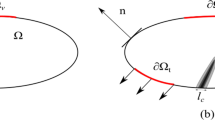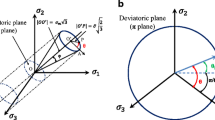Abstract
Design and realisation of a metal blanking process in current industrial practice are mainly based on empirical knowledge. For more sophisticated applications, involving high accuracy geometry specifications, or non-standard materials and product shapes, this empirical approach often fails. This paper presents a set of interrelated numerical techniques resulting in a finite element model of the metal blanking process, focusing on the prediction of the shape of the cut edge of a blanked product. The large, localised deformations are handled by an Operator Split Arbitrary Lagrange Euler (OS-ALE) method supplemented by full remeshing. Transport of the state variables between subsequent meshes for the OS-ALE and remeshing methods is accomplished by the Discontinous Galerkin (DG) method and an interpolation procedure, respectively. Ductile fracture is incorporated using a discrete cracking approach, which is shown to generate mesh independent results.
Similar content being viewed by others
Author information
Authors and Affiliations
Additional information
Received 4 February 2000
Rights and permissions
About this article
Cite this article
Brokken, D., Brekelmans, W. & Baaijens, F. Discrete ductile fracture modelling for the metal blanking process. Computational Mechanics 26, 104–114 (2000). https://doi.org/10.1007/s004660000158
Issue Date:
DOI: https://doi.org/10.1007/s004660000158




